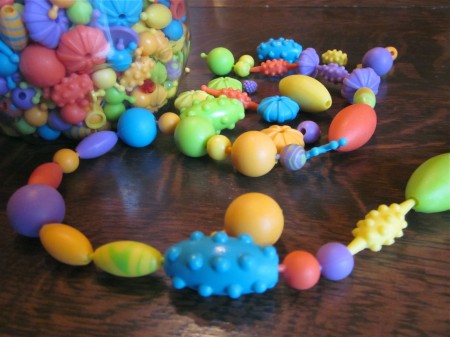 My kiddos are huge fans of popping pop beads, stringing beads, connecting nuts and bolts, and just sticking things together.
My kiddos are huge fans of popping pop beads, stringing beads, connecting nuts and bolts, and just sticking things together.
Not only are these great activities to help develop kiddos’ fine motor skills, but it shows how connecting–putting things together–is a natural inclination for people.
I’ve found that among all of the comprehension strategies out there, connecting is one of the easiest for children to learn and for parents to model. It’s one that we do around here most often, without thinking, because it’s natural to try to figure out where we fit compared to the world around us.
Many important reading comprehension strategies can be taught to children even before children can read–they just take some solid modeling by parents and teachers during read alouds. Connecting, activating schema, questioning, predicting, visualizing, inferring, determining importance, or synthesizing, can all be taught in casual, relaxed–but meaningful–ways during the short span of a read aloud.
Here are a few ways parents can model for their children the reading comprehension strategy of making connections:
- Making Connections: Making connections is usually one of the first reading comprehension strategies that children do naturally when reading a text, since most young ones looove to talk about themselves.
When your daughter shouts, Mommy! I have the same pink tutu as Zoe! while reading a Sesame Street book, she’s making a connection. Your son is making a connection when he says, Hey! There’s a clown fish like Nemo! during your trip to the aquarium. When Arthur’s Family Vacation gets your kiddos reminiscing about your own family’s crazy beach trip, they’re all making connections.
Connecting allows readers to relate directly to the characters, events, or ideas in a text. When readers are able to draw a connection to a text, they’re more likely to remember what they’re reading, appreciate what they’re reading, and be more invested in what they’re reading. Connections can be personal (self-to-text), they can be between two texts (text-to-text), or they can be between the text and some other world event (text-to-world).
During read alouds, parents or teachers can model connection-making by saying something like:
- I remember feeling the same way when I lost my favorite lovie. . .
- Oh, Lilly is so excited about her purse, she just can’t stop talking about it. When you got your new shoes, you felt the same way! Remember, you wanted to tell everyone how happy you were. . .
- It’s sometimes difficult to try new things. Michael in this book is just like Taylor in the book we read yesterday. . .
- It looks like the people in this story are really struggling with litterbugs. We just worked hard to pick up the litter we found in our park. . .
- Remember how the girl in The Gardner sent letters to her family while she was away, the little boy in this book. . .
Connections are pretty easy to make, no matter the text. And modeling this strategy doesn’t have to be a huge, time-consuming endeavor. If one or two connections are made during one read aloud, that’s great. Our hope is that when emerging readers–and even toddlers or preschoolers–hear the adults in their lives making natural connections as they read, that the little ones, too, will make connections when they are the ones decoding the text.
And when readers make connections, they’re drawing themselves closer to the text which will ultimately help them to better understand what they read. Very simply, we’re hoping that our little ones will pick up on the habits of strong readers early on, and then they will naturally use these strategies on their own when they’re able. Pretty awesome, right?
Originally posted as a series on ABC and 123: A Learning Cooperative, this is part of a series I’m starting here on Learning During Read-Alouds.

Great lesson…thanks!
thank you, thank you, thank you!
Nicely done!
You’ve described this important reading comprehension skill in a way that parents can understand, teach, model, and encourage.
Have you read 7 Keys to Reading Comprehension? This book suggests parents and teachers model thinking out loud just like you explained.
I look forward to more of your Learning During Read-Alouds posts.
Michelle! Thanks so much, my friend–that was my goal, and to hear from a fellow teacher and reading buff that it makes sense made my night!
I’ve been a reader of your blog from the very beginning, (seriously the very beginning). Teach Mama is one of my very favorite sites! This post is one of those fabulous Teach Mama posts and the reason why so many parents and educators read your blog. Thanks again Amy for helping us make those connections during read-alouds!
Holly. I want to hug you. Thanks so much for your incredibly kind words. You’ve made my year.
xo
I so, so, so love making these connections with my kids when I’ve had a rough day or they have. We have a book called “when Sophie gets angry, really really angry” and it’s just a good way to help my kids connect with why I shouted or they did or why we get mad and why mommy went into her room for 5 minutes for quite time. It’s helped my kids understand a LOT about our feelings and more so that they are completely normal…
Anyway…great post!
Rachael! I have to check out that book–thank you for mentioning it to me!! Cannot wait to find it. You are so awesome for sharing a title that’s helped you guys make connections–important ones.
Making connections is our favorite reading skill! It’s so easy and powerful. I love this post, and I can’t wait to read the rest of your Learning During Read-Alouds series!
Thank you, Erin!! You are so awesome to write–looking forward to writing the Read-Aloud series. . . and if you’d ever be up for guest posting, let me know!